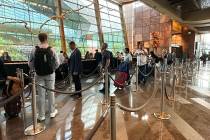LVCVA chief to lead national Travel Association
Rossi Ralenkotter has begun a two-year term as the point person for the $1.8 trillion U.S. travel industry.
But that role won’t take away from his job overseeing Las Vegas’ annual $40 billion tourism market.
Actually, the issues Ralenkotter hopes to champion for destinations across America — boosting the nation’s transportation infrastructure, promoting the value of meetings and conventions, and expanding visa waiver reform to increase international tourist visitation — also influence Las Vegas.
Ralenkotter, chief executive officer of the Las Vegas Convention and Visitors Authority, said the nation’s travel industry is at a crossroads. As the economy rebounds from the recession, tourism continues to play a critical role in the recovery. In many American destinations, travel is among the top three drivers of economic stimulus.
In Las Vegas, tourism is clearly No. 1. If the Strip trends positive, Southern Nevada follows along.
As chairman of the Washington, D.C.-based U.S. Travel Association’s board of directors through 2014, Ralenkotter is the face and primary advocate for the organization, which represents all facets of the tourism business
“It gives Las Vegas a seat at the table to take a stronger position on the decisions made in Congress that impact travel in the U.S.,” he said.
Ralenkotter, who is entering his 40th year in the tourism industry, has been on the association’s board for the past 12 years and chaired various committees, working his way toward the chairman’s position.
In 2013, Las Vegas will host the U.S. Travel Association’s International Pow Wow, the industry’s premier trade show promoting international visitation.
Ralenkotter’s initial effort as chairman will be unveiled Monday when the U.S. Travel Association rolls out “Keeping America Meeting,” a blueprint to strengthen various aspects of the meetings industry.
Corporate meetings and business travel were discouraged during the recession. Cost cutting gave way to high-tech solutions, such as online meetings.
But the industry touts the face-to-face aspect found in trade shows and conferences, which also benefit the host community.
Ralenkotter said convention business is critical to economic growth. In 2009, the meetings industry contributed
$458 billion to the nation’s gross domestic product, employed 1.7 million Americans, and supported 4.6 million indirect jobs.
In Las Vegas, convention and meeting business attracted more than 4.8 million of the market’s 38.9 million overall visitors in 2011, had an economic impact in excess of $4 billion and is responsible for 46,000 jobs.
The business is also a factor in Las Vegas’ recovery. The city is home to the Las Vegas Convention Center and the Sands Expo and Convention Center, two of nation’s largest convention facilities.
Last month, MGM Resorts International Chairman Jim Murren said the convention calendar at his company’s Strip properties improved in 2011 and is stronger in both 2012 and 2013. MGM Resorts operates large meeting facilities at the MGM Grand, Aria and Mandalay Bay.
An active convention and meeting business translates into increased average daily room rates and a boost in revenue per available room, a nontraditional indicator of profitability that includes spending on gaming and non gaming attractions.
“We want to make sure that business travel remains vibrant,” Ralenkotter said.
He also has other goals.
The nation’s travel transportation infrastructure — roads, rail lines, airline service and airport facilities — needs continued attention “so it’s easier to move people from Point A to Point B.”
International visitation remains at the top of his agenda, and for a good reason.
Roughly 8 percent to 10 percent of all international travelers to the U.S. come to Las Vegas, according to the convention authority’s research division. About 16 percent of Las Vegas’ total visitors are international. Ralenkotter’s goal is to increase that number to 30 percent.
The opening of the $2.4 billion Terminal 3 at McCarran International Airport, which will include seven state-of-the-art gates dedicated to international flights, is a piece of the puzzle.
Ralenkotter also advocates expanding the number of participating countries in the Visa Waiver Program. In January, President Barack Obama issued an executive order seeking to boost tourist visa processing in China and Brazil, and speeding the application handling for visitors in general.
“It would create a more welcoming environment when international travelers enter the country,” he said.
Ralenkotter joined the convention authority in 1973 to handle marketing research. There wasn’t much in the way of competition to Las Vegas at the time. The city had roughly 27,000 hotel rooms and about 8 million annual visitors.
Today, gaming is spreading throughout the U.S. and worldwide. Macau passed Las Vegas in gaming revenue production a few years ago. Singapore could become the world’s No. 2 gaming market this year.
Ralenkotter said Las Vegas remains a primary travel destination for both domestic and foreign travelers. His goal is to keep the market at the forefront.
“We’re still the gaming capital of the world,” Ralenkotter said.
Howard Stutz’s Inside Gaming column appears Sundays. He can be reached at hstutz@reviewjournal.com or 702-477-3871. He blogs at lvrj.com/blogs/stutz. Follow @howardstutz on Twitter.












